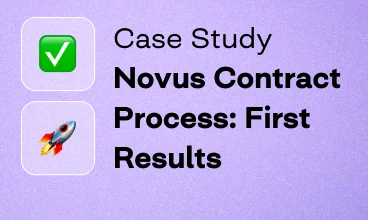Contract management is complex and can be extremely time-consuming. It often requires a significant amount of resources and is subject to error. Contract management automation is a streamlined solution that improves efficiency and lowers risk.
Low-code tools help businesses automate contract processes without technical expertise. User-friendly drag-and-drop interfaces, ready-made templates, and customizable workflows simplify the contract lifecycle from creation to renewal.
In this article, we examine how low-code solutions can transform contract management, how to implement workflow automation, and the benefits of adopting these tools to increase productivity and reduce errors.
What is Contract Management Automation?
Contract Management Automation (CMA) represents a technological system for the digital transformation of contract operations from drafting to renewal. The introduction of smart software solutions replaces traditional paper-based processing with automated document creation, workflow dispatch, approval screening, and compliance assessment functionalities. CMA systems use artificial intelligence and machine learning to analyze contract terms, extract key data points, and detect potential risks, ensuring organization-wide standardization. This modern approach significantly reduces human errors, administrative workload, and contract processing time while providing detailed analytical reports.
The Role of Low-Code Tools in Contract Management
The rise of low-code technology enables legal staff and business professionals to build, maintain, and automate contracts through intuitive interfaces that eliminate the need for coding expertise. These platforms combine user-friendly environments with pre-built components and drag-and-drop features, removing technical barriers when deploying contract automation solutions.
- Gartner predicts that low-code and no-code technologies will be present in 70% of enterprise new application development projects by 2025 while remaining below 25% in 2020.
- Research and Markets predicts that the global contract lifecycle management market will grow from $1.7 billion in 2022 to $4.1 billion by 2027, driven by increased adoption of low-code solutions.
Using these tools organizations can quickly execute contract workflows, build custom templates, and automate approval processes without the need for extensive IT involvement. A Forrester study shows that low-code platforms accelerate development by up to 10 times compared to traditional programming. Aberdeen Research found that companies using low-code contract solutions reduced their contract handling time by 82%.
Key Processes Streamlined with Low-Code Solutions
Low-code solutions carry out modern contract management by making complex manual procedures quicker and simpler. The platform offers connected features that handle contract operations from inception to completion so organizations can deliver enhanced productivity and superior quality.
Contract Generation with Templates
Low-code solutions allow users to generate standardized agreements using templates that ensure legal compliance. A dynamic template system with a pre-approved clause library enables users to access related information from connected systems which automatically populates into the templates. The automated system generates contracts 82% faster with minimum possibility of errors and unauthorized changes.
Contract Negotiation
The collaborative negotiation processes of low-code solutions enable all parties to use interactive work areas that offer real-time review tracking and commenting functions. The solutions conduct full records of all changes and interactions.
Contract Approval
Low-code solutions automate approval workflows, eliminating bottlenecks by routing contracts to designated stakeholders based on predefined criteria. These systems also incorporate escalation protocols to ensure timely approvals and offer mobile accessibility for remote decision-making.
Contract Signing
Organizations leverage digital signatures integrated with low-code solutions to automate signature agreements, achieving faster contracts while overcoming geographical challenges. The systems have built-in legally valid e-signature features that track users and authentication protocols. Using digital signing solutions allows organizations to complete documents 80% faster than manual methods while ensuring compliance with eIDAS and the ESIGN Act.
Contract Tracking
Low-code systems deliver real-time contract tracking through adaptive dashboards and automated alerts. Organizations can track essential dates, obligations, and timeframes, as well as generate automatic alerts before upcoming deadlines that may impact compliance.
Contract Renewal
The renewal process gets streamlined because automated systems track expiration dates and start the renewal processes at set time points. Low-code solutions evaluate historical performance records to highlight problematic terms so users can review them and receive automated renewal suggestions. Through this proactive methodology organizations prevent unwanted auto-renewals while finding new opportunities for contract enhancement because systems provide strategic decision timeframes between 90 to 120 days beforehand.
Storage and Archiving
Modern low-code contract management systems create secure centralized storage solutions that enable efficient and accessible contract storage and retrieval processes. Organizations can guarantee compliance through advanced encryption methods and role-based access controls to create documents available for properly authorized personnel access.
How to Automate Contract Workflows with Low-Code Tools
Businesses that use workflow automation through low-code tools streamline operations, automate manual tasks, and boost operational efficiency. By combining customizable workflows with pre-built templates and drag-and-drop interfaces, companies can automate complex processes, including contract management document tracking and approvals. The following instructions provide a sequential plan for implementing workflow automation through low-code solutions.
1. Identify Processes for Automation
Analyze your current workflows to identify repetitive manual tasks that consume a lot of time while also creating possibilities to make errors. Document workflow automation produces outcomes for several contract management processes including document creation, negotiation stages, executive review functions monitoring mechanisms, and the renewal stages.
2. Select the Right Low-Code Platform
Choose the right low-code platform for seamless automation. Look for platforms that offer:
- Intuitive drag-and-drop interfaces for easy workflow design
- Pre-built templates to accelerate development
- Customizable workflows tailored to your business needs
- Seamless integration with existing systems (CRM, ERP, document management)
3. Design Your Workflow
Use the platform’s workflow design tools to map out the automation process. Define key stages, such as:
- Data input (e.g., contract details, approvals)
- Automated triggers (e.g., notifications, document routing)
- Decision points (e.g., approval or revision loops)
- Final actions (e.g., contract storage, task completion)
4. Test Workflows Before Deployment
Before rolling out the automated workflow, conduct rigorous testing to identify and resolve potential issues. Simulate different scenarios to ensure that the process runs efficiently under various conditions.
5. Train Your Team for Adoption
Provide hands-on training to ensure employees understand how to use the new centralized system effectively. Offer user guides, demo sessions, and ongoing support to ease the transition.
6. Monitor Performance and Optimize
Once implemented, track key metrics such as process completion times, error rates, and user adoption. Continuously refine and enhance your workflow automation to maximize efficiency.
By following these steps, businesses can harness the power of low-code tools to automate workflows, improve collaboration, and boost productivity. Investing in contract management automation and other process optimizations ensures long-term success and scalability.
Benefits of Streamlined Contract Management with Low-Code Tools
The combination of contemporary contract lifecycle management systems built on low-code platforms transforms how companies handle legal documents and contracts.
Businesses that adopt contract workflow automation reduce their manual workload by 80% and decrease compliance dangers. Organizations that adopt digital contract management eliminate document processing slowdowns while achieving full-time access to contract timelines, commitments, and deadlines.
Low-code contract automation tools facilitate users to build templates swiftly and manage standardized approval procedures alongside automated renewal date alerts. The improved system brings faster contract completions together with better vendor management and regulates both vendor and corporate relations according to legal standards
Through its centralized storage system organizations can easily find their agreements and monitor them together with complete documentation history. Organizations experience better risk management outcomes because automated compliance checks work in combination with standardized language together with proactive deadline monitoring systems.
soft Xpansion Low-Code Solution for Contract Management
Operation efficiency depends on effective contract management for businesses that aim to minimize risks while upholding compliance requirements.
The soft Xpansion Low-Code systems offer a flexible, secure, and customizable solution that simplifies the entire contract process, from creation to execution and renewal:
Key Features of soft Xpansion's Contract Management Solution
- Automated Contract Creation – Use pre-built templates with auto-filled fields based on contract attributes and business rules.
- Approval & Signing Workflows – Set up structured approval chains and integrate with electronic signature services (Adobe Sign, DocuSign, Diia. Sign, etc.) for legally binding agreements.
- Centralized Document Storage – Organize contracts in a secure digital repository with advanced search, categorization, and access control.
- Collaboration & Task Management – Enable teams to work on contracts simultaneously, track changes, and manage tasks via role-based workflows.
- Integration with ERP & CRM – Seamlessly connect with SAP, Microsoft Dynamics 365, Salesforce, and other enterprise systems to enhance contract-related data processing.
- Compliance & Audit Tracking – Monitor contract versions, approval history, and compliance status to ensure regulatory adherence and mitigate risks.
- Renewal & Expiry Notifications – Set up automated alerts for contract expirations, renegotiations, and renewals, preventing missed deadlines.
soft Xpansion’s Low-Code contract management solutions reduce contract processing times, minimize human error, and provide businesses with full control over contract lifecycle tracking. The platform features a flexible architecture and customizable options, allowing businesses to develop contract workflow systems tailored to their unique operational requirements
Conclusion
Business operations benefit greatly from Low-Code contract management solutions because they decrease manual labor while implementing better compliance standards and promoting effortless departmental collaboration. The soft Xpansion Low-Code platform provides you with a flexible secure and adjustable solution that makes the whole contract process simpler starting from creation through execution up to renewal.
Visit soft Xpansion right now for a demo that will demonstrate how their tools optimize your business contract operations along with workforce productivity enhancements.
FAQ
Q1: What role do low code tools play in contract management?
Low-code tools simplify contract management by offering drag-and-drop interfaces, pre-built templates, and customizable workflows. These features enable businesses to automate contract processes efficiently without requiring extensive technical expertise
Q2: Why do you need to automate contract management?
Benefits include increased efficiency, fewer errors, better collaboration, better visibility, and cost savings.
Q3: What aspects of contract management can be automated?
Low-code tools can automate processes such as contract creation, negotiation, approval, tracking, and renewal.
Q4: Which low-code platform is right for my business?
Choose a platform that’s friendly for users, and has customizable workflows and powerful templates. It should also fit your particular needs for contract management.
Q5: How does team training contribute to the implementation of low-code solutions?
Effective team training ensures that users understand the platform, workflows, and best practices, facilitating a smooth transition and maximizing the benefits of automation.
Q6: Can low-code solutions be integrated with existing systems?
Yes, most low-code platforms seamlessly integrate with enterprise systems such as CRM, ERP, and document management tools, creating a cohesive contract management ecosystem.
Q7: Can large-scale contract management be done with low code?
Absolutely. By using low code tools, you can scale to manage high volumes of contracts while also gaining centralized oversight and automation.





